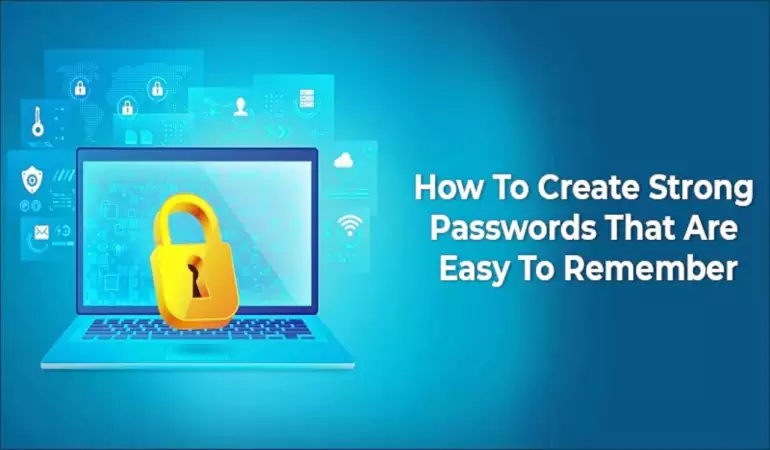How to Create a Strong Password - Step-by-step Guide
Creating strong passwords may seem like a daunting task, especially when the recommendation is to have a unique password for each site you visit. Anyone would be overwhelmed if they had to create and memorize multiple passwords like Wt4e-79P-B13^qS.
August 21, 2023 15:39
In an era marked by escalating cyber threats, the significance of fortified digital security has never been more evident. Safeguarding your online presence is paramount, and at the forefront of this defense lies the humble yet crucial element: strong passwords.
As hackers become increasingly sophisticated, adopting robust password practices becomes non-negotiable. This article aims to empower you with the knowledge needed to craft unyielding passwords, fortifying your digital fortress against potential breaches.
Join us as we delve into the art of password creation and equip you with a comprehensive guide to bolstering your online defenses.
Importance of Robust Passwords: Safeguarding Your Valuable Information
In our digital age, comprehending the critical role that strong passwords play in shielding your personal and sensitive data is paramount. This article delves into the significance of crafting and maintaining robust passwords, shedding light on the potential hazards of weak password practices.
Why Strong Passwords Matter: Guarding Your Precious Data
Solid passwords act as a formidable barrier against cyber threats, forming the first line of defense for your online accounts and confidential information. By incorporating a mix of uppercase and lowercase letters, numbers, and special characters, you create a complex code that becomes exceedingly difficult for malicious actors to crack.
The Dangers of Weak Passwords: A Gateway to Catastrophe
Embracing weak passwords can expose you to a host of dire consequences. Identity theft looms as a significant risk, as cybercriminals exploit easily guessable passwords to impersonate you and exploit your personal information. Moreover, the specter of data breaches arises, potentially compromising not only your data but also the data of those interconnected to you.
Unauthorized access, the bane of digital security, becomes a stark reality when weak passwords are employed. Cyber attackers can stealthily infiltrate your accounts, leading to unauthorized control over your digital life. This intrusion can wreak havoc on both personal and professional fronts, leading to reputational damage and financial losses.
In essence, the value of robust passwords cannot be overstated. Crafting intricate passwords and regularly updating them forms an indispensable practice in fortifying your digital existence. By doing so, you proactively ward off the looming threats of identity theft, data breaches, and unauthorized access, safeguarding the sanctity of your invaluable information.
Characteristics of a Strong Password: Creating Secure and Unbreakable Passwords
When it comes to online security, crafting a robust password is your first line of defense. A strong password is essential for safeguarding your sensitive information from prying eyes and malicious actors. To ensure your digital safety, consider the following key elements when creating a password:
1. Optimal Length: Long passwords are harder to crack. Aim for a minimum of 12 characters to provide a solid foundation for your password's strength. The more characters you include, the better the protection against brute-force attacks.
2. Complexity Matters: Incorporate a mix of character types to enhance complexity. Combine uppercase and lowercase letters, numbers, and special symbols like punctuation marks or symbols. This intricate combination significantly raises the difficulty level for hackers trying to breach your account.
3. Uniqueness Is Key: Avoid reusing passwords across multiple accounts. Every online service you use should have its distinct password. This practice prevents a breach on one platform from compromising your other accounts.
Steer Clear of Common Pitfalls:
1. Say No to Common Passwords: Refrain from using common passwords such as "123456," "password," or "qwerty." These are the first combinations hackers attempt to breach an account due to their prevalence.
2. Ditch Dictionary Words: Using recognizable words found in dictionaries makes your password vulnerable. Hackers utilize dictionary attacks that run through commonly used words to crack passwords.
3. Avoid Easily Guessable Information: Stay away from personal information like birthdates, names of family members, or other easily accessible data. Hackers can gather this information from social media and other sources.
In conclusion, a strong password is your frontline defense against unauthorized access. By adhering to optimal length, complexity, and uniqueness principles, you fortify your digital security. Remember, avoiding common passwords, dictionary words, and easily guessable information adds an extra layer of protection. Safeguard your online presence with passwords that are both secure and easy to remember.
Investing time in crafting strong passwords now pays off immensely in the long run, providing you with peace of mind and confidence in your online interactions.
Creating a Strong Password: A Step-by-Step Guide
When it comes to safeguarding your online accounts, a strong password is your first line of defense. Crafting a robust password might seem challenging, but with our step-by-step guide, you can fortify your digital security effortlessly.
A. Step 1: Choose a Phrase or Sentence
1. Selecting a Memorable Phrase: Start by picking a phrase or sentence that holds personal significance to you. This could be a favorite quote, a line from a song, or an inside joke. Choosing something memorable makes it easier to recall.
2. Avoiding Easily Guessable Phrases: Stay away from obvious choices like birthdates, common phrases, or well-known quotes. The goal is to make it unique and difficult for others to guess.
B. Step 2: Mix Uppercase and Lowercase Letters
1. Importance of Letter Variety: Incorporating both uppercase and lowercase letters enhances the complexity of your password. This makes it more resilient against dictionary attacks and brute force attempts.
2. Strategic Placement of Uppercase Letters: Randomly replace some lowercase letters with uppercase ones. Avoid predictable patterns like capitalizing the first letter of the phrase.
C. Step 3: Incorporate Numbers
1. Using Meaningful Numbers: Integrate numbers that hold personal significance, but avoid obvious choices like your birth year. Select numbers that are meaningful to you, but not easily discoverable by others.
2. Avoiding Predictable Number Patterns: Steer clear of sequential or repetitive number patterns, as they weaken your password's strength. Instead, scatter the numbers throughout the phrase.
D. Step 4: Add Special Characters
1. Selecting Appropriate Special Characters: Choose special characters that are allowed by the website or service you're creating the password for. Opt for a mix of symbols like !, @, #, or %.
2. Balancing Special Character Placement: Don't clump the special characters together. Distribute them organically within the phrase to maintain a good balance.
E. Step 5: Ensure Length and Complexity
1. Optimal Password Length: Aim for a password length of at least 12 characters. Longer passwords are generally more secure against hacking attempts.
2. Creating Complexity Through Variety: The more diverse your password's elements (letters, numbers, special characters), the more intricate it becomes. This complexity deters hackers and unauthorized access.
F. Step 6: Test the Password Strength
1. Online Password Strength Tools: Use online password strength tools to evaluate how secure your password is. These tools analyze factors like length, character variety, and unpredictability.
2. Manual Assessment of Password Resilience: Gauge your password's resilience by putting yourself in a hacker's shoes. Consider whether someone familiar with your life could easily guess the elements you've used.
By following these steps and customizing each element, you'll craft a strong password that's not only hard to crack but also easy for you to remember. Enhance your online security with a password that truly stands guard over your valuable digital assets.
Additional Tips for Enhancing Password Security
When it comes to safeguarding your online accounts, employing effective password security practices is paramount. In addition to the fundamental measures discussed earlier, there are several other essential steps you can take to fortify your digital defenses:
A. Utilize Distinct Passwords for Each Account
Employing unique passwords for every online account is an indispensable tactic. This prevents a security breach on one account from compromising your other accounts. Crafting distinctive passwords that incorporate a mix of upper and lower-case letters, numbers, and symbols significantly heightens their resilience.
B. Implement Two-Factor Authentication (2FA)
Two-factor authentication (2FA) is an invaluable tool that adds an extra layer of security to your accounts. By requiring a secondary form of verification in addition to your password—such as a code sent to your phone or email—2FA thwarts unauthorized access even if your password is compromised.
C. Regularly Update Your Passwords
Frequently updating your passwords is a strategic move to stay one step ahead of potential security breaches. Regular changes inhibit hackers from exploiting long-standing vulnerabilities. Set a reminder to refresh your passwords every few months and avoid reusing old ones.
D. Harness the Power of Password Managers
Password managers are indispensable allies in the quest for robust password security. These tools generate and store complex, unique passwords for each of your accounts. With the convenience of accessing them through a master password, you can eschew the risk of forgetting or using weak passwords.
By incorporating these supplementary tips into your password security strategy, you can significantly mitigate the risks associated with online threats. Strengthen your defenses and ensure the safety of your sensitive information across various digital platforms.
Password Pitfalls to Avoid
When it comes to safeguarding your online accounts, steering clear of certain password pitfalls is paramount. In this section, we'll shed light on two critical aspects that can significantly enhance your digital security.
A. Commonly Used Weak Passwords
Opting for a strong and unique password is your initial line of defense against cyber threats. Unfortunately, many individuals still fall into the trap of using commonly used weak passwords, making their accounts vulnerable to breaches. A weak password is akin to leaving your front door wide open for hackers. Passwords like "123456," "password," or "qwerty" might be easy to remember, but they're also the first ones cybercriminals try. Crafting a robust password involves a mix of uppercase and lowercase letters, numbers, and symbols. This intricate blend acts as a fortified barrier, deterring unauthorized access and preserving your digital privacy.
B. Avoiding Easily Accessible Personal Information
Personal information, while crucial for account recovery, can also be a double-edged sword if used carelessly. Many people unknowingly incorporate easily accessible details into their passwords, such as birthdates, names of family members, or favorite hobbies. Hackers are adept at scouring social media profiles and public records to gather such information. By weaving these elements into your password, you inadvertently provide a roadmap for cybercriminals to crack your security. To counter this, devise passwords that are entirely unrelated to your personal life. Choose random words, use a passphrase, or create an acronym from a memorable sentence. This strategy erects an additional layer of protection, preventing hackers from exploiting your personal data.
However, evading password pitfalls is pivotal in fortifying your online security. By steering clear of commonly used weak passwords and refraining from incorporating accessible personal information, you'll significantly bolster your defenses against cyber threats. Your digital well-being deserves nothing less.
Conclusion
In wrapping up our discussion, it's crucial to underscore the significance of maintaining strong passwords for bolstering your online security. In today's interconnected digital landscape, safeguarding your sensitive information has never been more paramount. By adhering to the best practices outlined in this guide, you're taking a proactive stance in fortifying your digital defenses against potential threats.
To truly empower yourself with robust online security, we wholeheartedly encourage you to follow the step-by-step guide we've provided. Embracing these practical measures will not only shield you from unauthorized access but also grant you the peace of mind you deserve while navigating the virtual realm.
Remember, the responsibility of safeguarding your digital presence rests squarely on your shoulders. By adopting strong passwords and embracing the insights shared in this guide, you're forging a path toward a safer and more secure online experience. As technology evolves, so do the tactics of cyber attackers, making it imperative to stay vigilant and stay informed. Your online safety is an ongoing journey, and every effort you invest today will pay dividends in the safeguarded future that awaits.











